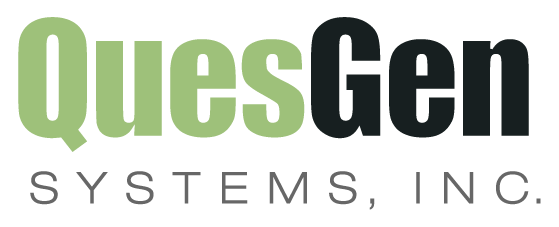Frequently Asked Questions
Is our data secure?
We use all industry standard methods to ensure that your data is secure. All data communication between your browser and our secure servers happens through a Secure Socket Layer (SSL) connection and is encrypted. Our servers are located in a SAS-70 compliant data center behind a dedicated firewall. All of the members of our team are experts in managing secure HIPAA data.
We have an existing database that we are using today. Can we migrate the data into the QuesGen System?
Yes, we can load the data if you can provide it to us in a standard format. We also have tools that can load data directly from Microsoft Access databases.
What do I need to run the system?
All access happens through a browser. There are no servers or special hardware requirements. All you need is a PC with a reasonably current browser.
My IT department gave me a bunch of security requirements that I don’t understand. Can you work with them to address them?
Yes, we have been through that process many times. We have detailed documentation that we can provide and can also work with your IT Security staff to address any questions or concerns that they have.
How long does it take to get a study set up?
It depends on how much work that we have to do. Typical projects are setup in one to two weeks, but larger, more complex systems can take longer.
I can see how the forms work for getting data in, but how do I get it out for analysis?
We provide extract tools that allow you to select the data elements that you want to include, provide an ability to define the criteria and allow you to download the file in a standard format that can be easily loaded into any stats package or excel.
How much does it cost?
The QuesGen platform is delivered using the Software as a Service (SaaS) model. That means that you pay for the software only as you use it, rather than a large up-front purchase. There is a per-user, per-month charge, as a setup fee which will cover the time required to configure your site by our team. For more information about your specific situation, please contact us.
There are members of our team who have different roles (like data entry and data analysis, for example). It is ok for some to see PHI but not others. How can we handle that?
Each user can have a unique permission profile. It can either be assigned individually or by group (e.g Data Analyst, Research Assistant, Site Administrator). Each user has PHI (Protected Health Information) indicator which will prevent or allow access to PHI.
What types of studies can be done?
The platform has been designed to handle large, complex, multi-center studies. Of course, we have many projects that are much simpler in nature. Most of our projects are unique. For example, we have done work in hematology, pediatric stroke, and peripheral arterial disease. We have a number of clients in Traumatic Brain Injury (TBI) and pediatric obesity. For both of those, we have a large number of pre-developed forms and data structures.
Like the previous question, we would like to be able to allow different sites to enter data, but only have access to the data that they entered. We would like for the study coordinator to see all of the data. Can that be done?
Users can also be configured so that they have access only to data associated with a specific category (e.g. Site). Other users can be configured to have access to all levels of data.
I don’t know much about data management, do I need to get an expert on board before getting started?
No, we can work with your team and provide direction for the optimal data model for ease of data entry and analysis. Typically, our clients will rely on statisticians to do the data analysis. We can provide that assistance as well if required.
Some of our people have Macs. Do they work?
Any PC or Mac will work fine. We work with current versions of all of the major browsers, including Firefox, Safari, Chrome, and IE.
What if there is a disaster? What will happen to our data?
Our data is backed up securely every night and an encrypted copy is sent to a remote server. Should there ever be a problem that would take out the entire data center, a remote copy could be available quickly.
